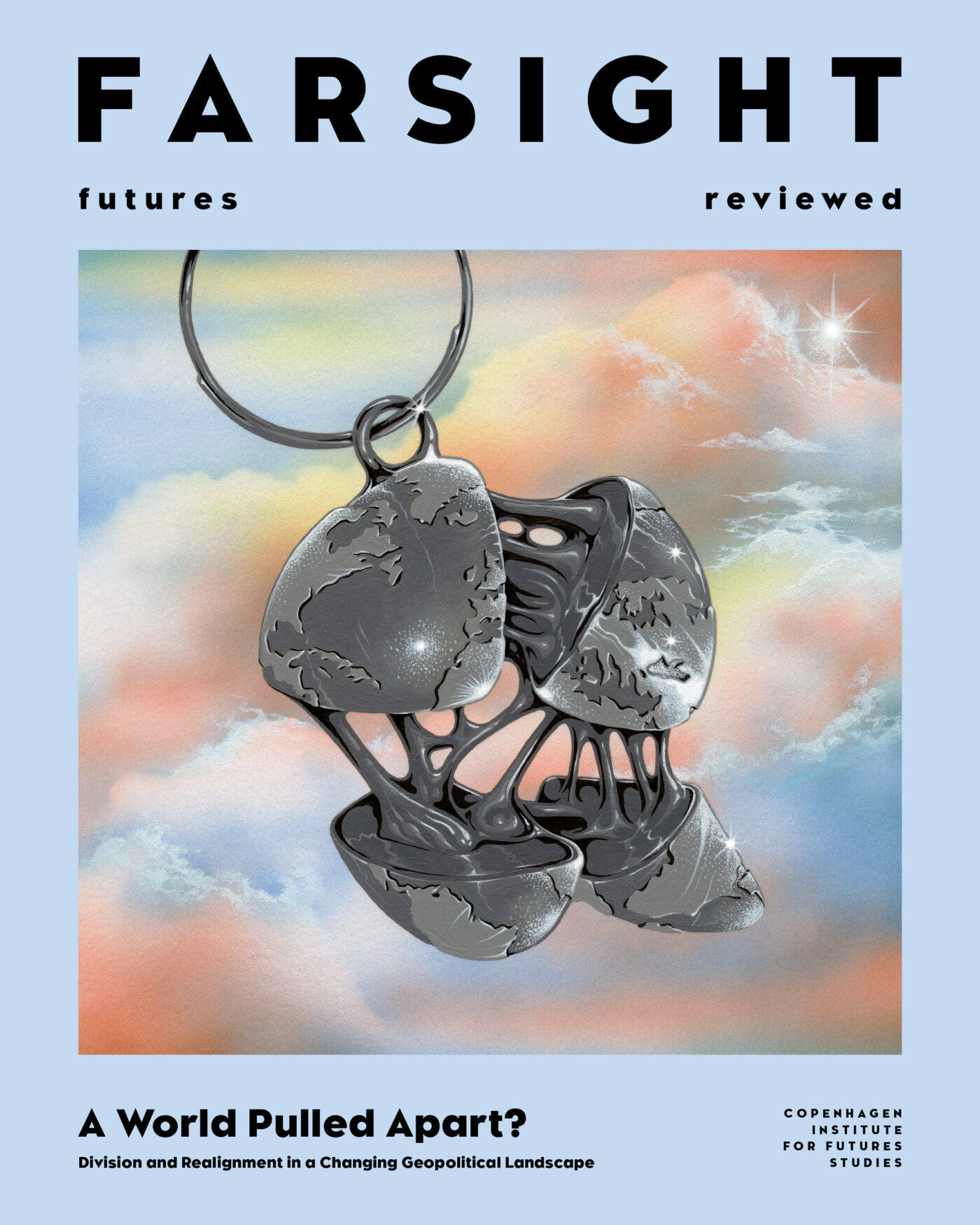
In turn, we use cookies to measure and obtain statistical data about the navigation of the users. You can configure and accept the use of the cookies, and modify your consent options, at any time.

Breaking Up in Outer Space
How the emerging multipolar world
order complicates the ideal of peaceful
co-existence in the cosmos.
In 1967, a historic UN treaty came into force which today, more than five decades later, still forms the basis for international space law. The Outer Space Treaty (OST) was an ambitious document declaring outer space to be a zone for collaboration and peaceful co-existence – a ‘province of all mankind’. Along with the handful of other treaties that came after it, the OST also set the practical ground rules to be followed by any nation or private enterprise with space-faring ambitions.
The signing of the treaty had been preceded by a period of fierce competition between increasingly ambitious space nations – chiefly the US and USSR – as well as the emergence of new and frightening weapons of mass destruction, including intercontinental ballistic missiles designed for delivering nuclear weapons over great distances and capable of reaching targets even in outer space. Against this backdrop of cold war competition, the OST stood out as a highpoint of collaboration between East and West. Importantly, it banned the use and presence of nuclear weapons in space, aiming at a de-militarisation of the cosmos. In keeping with the spirit of the time, the burgeoning field of space law was likewise characterised by a hopeful and optimistic outlook for the future.

“There was this idea that we were entering a new era, and that we could forget about things like jurisdictions and national borders because we would find completely new ways of cooperating,” says Katrin Nyman-Metcalf, Adjunct Professor of Communications Law at Tallinn University of Technology in Estonia. Throughout her career, she has worked on issues related to law and technology, including space law, and has followed the recent shift from cooperativeness to suspicion amongst space-faring powers.
“In the decades since the 1960s, as the novelty of space has worn down, so have the hopes that space can be a place that transcends the geopolitics of Earth,” she says. “Following the outbreak of war in Ukraine, we have seen new ruptures and provocations, one example being Russian astronauts aboard the International Space Station waving the flags of the breakaway republics of Ukraine,” she explains.

Professor Mark Sundahl, Director of the Global Space Law Center in Cleveland, agrees that things are currently trending in the wrong direction. Following the planned de-orbit of the International Space Station in 2031, Sundahl foresees a new phase of human space activity characterised by the reordering of nations into blocs mirroring the geopolitical camps of Earth.
“On the US side we will have privately owned space stations, which NASA will use. There will be Chinese space stations as well, and Russia has announced that they will build one too. On the moon, it looks like we will have an American-led camp and a joint camp shared by the Russians and Chinese. Hopefully we will see these two camps coexist, sharing infrastructure or engaging in joint projects and resource extraction.”
In some ways, NASA’s recently launched Artemis Program, which aims at establishing the first permanent human presence on the moon by the late 2020s, echoes the progressivism and internationalist principles of the early space age. So far, 21 signatories have joined Artemis, putting the number of participating nations higher than that of the International Space Station. Yet neither China nor Russia have thrown their lot in. India, another emerging space power, has also not signed the agreement.
Out of these three nations, Russia’s absence from the Artemis Program is perhaps the most predictable, given the recent cooldown of US-Russia relations in the wake of the Ukraine war. But China’s omission, too, should come as no surprise, as the last decades have seen the US become increasingly wary of engaging in collaboration with China on the technical level. In 2011, due to a suspicion that China had been using information provided to them by US satellite manufacturers to improve their intercontinental ballistic missile technology, the US Congress passed a law prohibiting NASA from collaborating with the Chinese government or any other Chinese organisation without prior approval from both the FBI and Congress. In practice, this law all but prohibits cooperation between American and Chinese scientists and engineers in space.
“On the legal side, I’m allowed to cooperate with my Russian and Chinese colleagues. But engineers and launch companies do not have that same freedom,” Sundahl explains. “It’s unfortunate because I think we need to cooperate more.”
The crowding of outer space by ambitious new entrants creates challenges for those whose job it is to ensure that everyone plays by the rules. There are many threats to the orbital ecosystem that put existing space law under pressure, and one of the most pressing ones has to do with the space debris that is created when nations test the capabilities of their anti-satellite weaponry.
“China conducted a kinetic anti-satellite test in 2007, and it created massive clouds of debris that will be in orbit for hundreds of years and which regularly threaten the ISS and other satellites,” Sundahl explains and continues: “Then, in 2008, the US conducted a similar test, but at a much lower altitude. A couple of years ago, India followed suit to show that they were part of the club, and then Russia conducted a test just recently. So, in the last 15 years several countries have conducted anti-satellite tests, and it’s now become a major problem.”
The issue, Sundahl says, isn’t that there are no rules to be followed when it comes to avoiding the problem of uncontrolled space debris. The UN Orbital Debris Mitigation Guidelines, for instance, were written to meet exactly this need. The trouble is that such guidelines are not legally binding, and so nations can mostly do as they please.
“It’s a ‘soft law’ rather than a binding treaty,” Sundahl explains. “Even though the law is highly respected and, for the most part, abided by, to give it teeth it needs to be implemented in national legislation. NASA, for instance, now has debris mitigation requirements that it must abide by. We will see whether other states will follow or not.”
The challenge of space debris illustrates why space law – like international law in general – is only as strong as the commitment of and level of trust between the states who must agree on it. If things take a turn for the worse on Earth, there’s little to suggest that the situation will be any different in outer space.
“There’s very little we can do when a country decides to violate an existing law. It’s built on diplomacy and the fact that countries have an interest in behaving themselves. The treaty system, built around countries wanting to cooperate, has worked so far. But it is a fragile system,” Katrin Metcalf says.
“One area where we may see conflict on Earth spill over into space is in relation to civilian remote sensing imaging technology, which can show you things that are relevant in conflicts. So, I don’t think countries would decide to spare one another in space if they had the capabilities to inflict damage.”
A conflict on Earth extending into space may be unavoidable, but could we imagine a scenario in which a conflict between nations is triggered by an incident in space, rather than the other way around? One potential source of quarrel, Mark Sundahl believes, can be found in the rapid advancement in offensive autonomous technologies that can cause havoc in Earth’s orbit.
“We now have drones flown by the US, and likely also by China, that can manoeuvre to a satellite, inspect it, and potentially ram it or use an electromagnetic charge to disable it. The ease with which this can now be done is something that could become a serious threat,” he says.
Then there is the competition for resources, especially ones that are needed in such large quantities that transportation from Earth is not feasible. As national space agencies and private enterprises establish permanent settlements on the moon, we may see them become increasingly controlling over access to certain natural resources found there, including ones that are not necessarily of strategic concern on Earth.
“With bases being built on the moon, we will need to extract water as it’s too expensive to bring from Earth,” Sundahl says. “On the legal side, this is an area where work is currently being done to set some ground rules and prevent conflict from erupting, including in The Hague and the UN where working groups are already trying to figure out how to regulate this activity.”
Although there is no shortage of potential threats to peace in the cosmos, conflict does not need to be an inevitability – not even in a scenario of increased antagonism between geopolitical blocs on Earth. One important factor that may contribute to keeping the peace, Katrin Metcalf believes, is the growing interdependence between nations, private corporations, and militaries in space.
“Overall, I do think that privatisation, from a security perspective, will help stabilise the situation. When telecommunications companies provide daily services via space technology – not only to civilians but to militaries as well – conflict in space comes at a higher price, not only for your adversaries, but for yourself as well.”
Mark Sundahl is also hopeful that the crowding of space by new actors will contribute to a more peaceful environment. Most of us will simply have too much to lose by upsetting the delicate power balance.
“The best catalyst for peace will be private activity,” he says. “All governments will eventually become reliant on private companies which I believe will make conflict in space more unlikely. This can be an opportunity to build something new if we manage to leave the frailties and flaws of our terrestrial life on Earth.” “Some people call me an optimist, but you have to work towards a better future.”

This is a featured article from our latest issue of FARSIGHT: A World Pulled Apart?